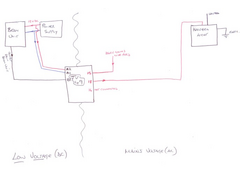2cv
|
| posted on 14/7/09 at 07:06 AM |

|
|
A question for electronics wizzes
I'm an absolute duffer with electronics so I'd appreciate a bit of help if possible please. I have a double beam intruder detector across
our lane which has a wireless receiver sounding an audible alarm when the beams are broken. There is also a 12 volt output from the receiver which I
could use to drive a 12volt coil 240 volt latching relay. I'd like to interface with one of those halogen floodlights that is normally operated
via an IR and has a timer built in. The question is what circuitry would I need to switch the lamp on keeping the timer but bypassing the lamp's
IR detector.
Thank you for your help.
|
|
|
|
|
YQUSTA
|
| posted on 14/7/09 at 08:04 AM |

|
|
Why not just get a lamp without the IR?
|
|
|
2cv
|
| posted on 14/7/09 at 08:12 AM |

|
|
I could certainly get a lamp without the IR but it wouldn't have a timer and my idea is to wire through the timer so that the lamp goes off
after the pre-set time and is then ready to light again the next time the alarm is triggered. A no-IR lamp plus standalone timer might be the answer
if such a thing exists.
I'm open to suggestions.
|
|
|
2cv
|
| posted on 14/7/09 at 08:23 AM |

|
|
A further thought. The IR security lights have a built in light level detector so that they can be set to operate only in low light conditions so this
is a good reason to use one of those lamps.
The other thought I've had is that once the lamp goes out the latching relay must be deactivated at the same time to return it to the
"Ready" position..
|
|
|
nitram38
|
| posted on 14/7/09 at 08:26 AM |

|
|
Why not just buy the IR light and fit it as it is?
It will just work as it should, instead you are just complicating the situation by trying to remove the IR and connecting it to your beam.
More things to go wrong............I'm a spark

|
|
|
MikeR
|
| posted on 14/7/09 at 09:30 AM |

|
|
my ir light turns on for a set time when it first gets power.
sounds ideal for what you want.
The only issue is if it gets power then loses it, then gets it - it stays on forever (as a feature to allow you to use it as a light).
Not sure they all do this though.
|
|
|
2cv
|
| posted on 14/7/09 at 09:32 AM |

|
|
Thanks Nitram you're right but we are in a rural area and the standard security light would be on and off all night long being triggered by all
the nocturnal wildlife such as foxes and badgers etc. The way I have in mind only a genuine alarm will activate the light.
|
|
|
greglogan
|
| posted on 14/7/09 at 10:57 AM |

|
|
feed the 12V output to a MultiFunstion timer such as a TV49 from CDC then use the switching side of the timer to switch your light on. For a TV49 you
use setting 'C' and set the time for whatever you want. The TV49 timer can switch upto 6 amps and will take any input voltage from 12v DC
to 250v AC.
If any of this makes no sense or you are not confident about the wiring side, I would try to help but I think you'd be better getting a spark
close to you to hook it up for you.
Costs about €33 + vat in Ireland.
Greg.
PS try
here for more info.
Any good electrical wholesaler (like Edmundsons) should have these in stock.
[Edited on 14/7/09 by greglogan]
Women are meant to be loved, not understood.
|
|
|
rgrs
|
| posted on 14/7/09 at 10:58 AM |

|
|
You can't easily use a combined flood/pir unit as the detection and timers are built onto one cheap pcb.
The industry standard (security) way to do what you want is to use a standalone floodlight controlled by a lighting controller using the beams as an
input.
Try a search for gjd lighting systems this might give you a few idea's
Roger
|
|
|
2cv
|
| posted on 14/7/09 at 12:24 PM |

|
|
Thanks guys for your help particularly to Greg.
Greg, thanks for the info on the TV49 which must I assume operate via a latching relay controlled by the alarm receiver. This will put the light on
for the pre-set time after which it will go out. However, nothing will have told the latching relay to unlatch. Do you have any ideas how that could
be done.
I'm sorry to be such a numpty.
|
|
|
greglogan
|
| posted on 14/7/09 at 02:22 PM |

|
|
the TV49 requires only a pulse to start it working (but requires a constant supply also at the same voltage as the pulse ie 12v in your case). It will
then stay active for a period of time that you can determine yourself. It basically has a relay built into it - albeit a small one. I don't
think there is any need to use a latching relay for the output from your beam unit as the TV49 only needs this input for signal purposes - it's
not carrying any load. The internal 6A relay in the TV49 will take care of the heavy lifting.
I'll try to organise a wiring diagram for you later.
I assume your beam unit is operated on a 12V power supply - DC?
Greg.
[Edited on 14/7/09 by greglogan]
[Edited on 14/7/09 by greglogan]
Women are meant to be loved, not understood.
|
|
|
2cv
|
| posted on 14/7/09 at 05:26 PM |

|
|
Greg, you are a star. Thank you for the trouble you have gone to on my behalf.
In answer to your question, the receiver is a 4052-GB from FM Electronics. Supply is from a mains transformer giving a supply voltage of 12volts dc.
The relay for the 12 volt output is rated max 1amp 12volts dc. The signal is set for 3 seconds.
That's all the information I can give you gleaned from the installation pamphlet.
Thank you once again.
|
|
|
greglogan
|
| posted on 15/7/09 at 07:51 AM |

|
|
So, I got out my crayons yesterday and had a go at drawing a wee wiring diagram. It's basic and crude (my crayons are much too big) but should
show you all you need to know.
!!!!!! Please Remember the Golden Rule of Wiring!!!!!!!
IF IN DOUBT WHEN WIRING, DON'T CHANCE IT! LEAVE IT TO AN EXPERT.
Sorry, that's my cross voice finished. Seriously though, be careful.
Greg.
*** Have deleted the pic as apparently SteveH's dog can resize pics. I am such a numpty with sizing pics - thanks Steve!
PS Full-size pic is in my photo archive conveniently called TV49.jpg
[Edited on 15/7/09 by greglogan]
Women are meant to be loved, not understood.
|
|
|
Steve Hignett
|
| posted on 15/7/09 at 08:07 AM |

|
|
 
2cv
|
|
|
2cv
|
| posted on 15/7/09 at 05:11 PM |

|
|
Greg and Steve, very many thanks for your help, I really do appreciate the time you have spent and for producing a diagram that even I can fathom.
Best regards
|
|
|













